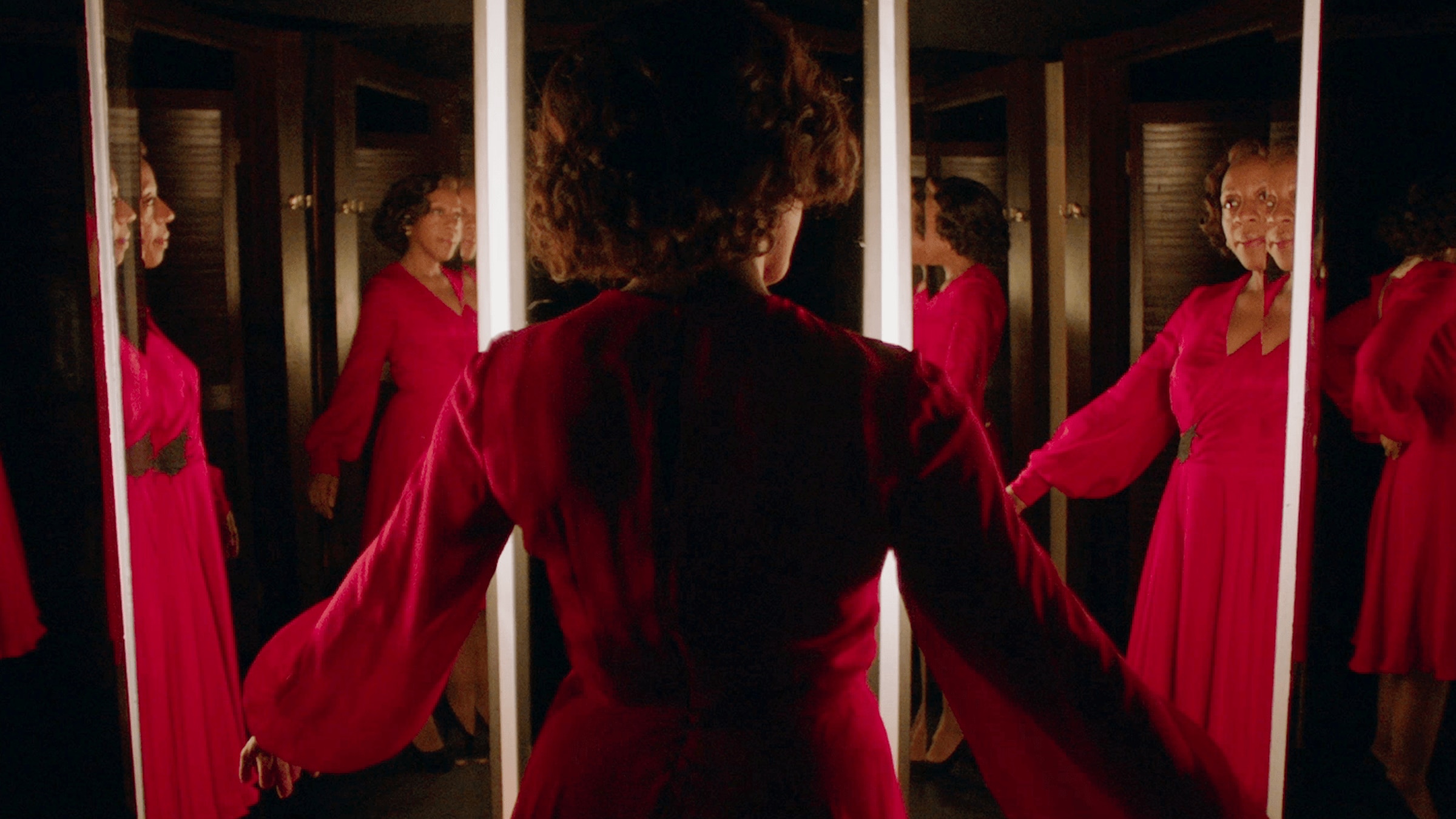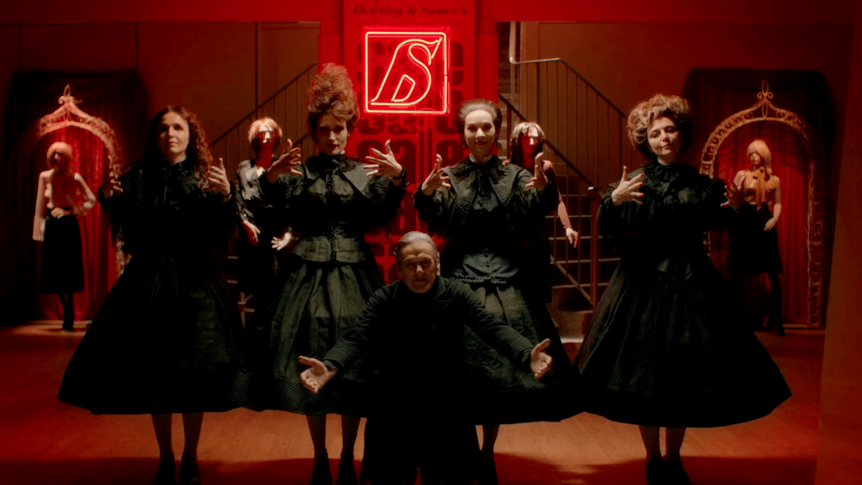Create a free profile to get unlimited access to exclusive videos, sweepstakes, and more!
Jo Thompson crafts a killer dress in couture horror In Fabric

In theaters on December 6 and to VOD on December 10, In Fabric tells the story of one killer dress. Killer as in “looks great” — deep scarlet with a near-universally flattering wrap-dress silhouette — but also killer in the sense that … er … it kills people. We don’t know how and we don’t know why. And we don’t know who—or what—the shopkeeper (Fatma Mohamed) who sells the dress to put-upon single mother Sheila (Marianne Jean-Baptiste) really is. All of this contributes to the lush, dreamy quality of this arthouse horror film, the fourth feature from English director Peter Strickland. (Strickland’s 2014 The Duke of Burgundy, about the BDSM relationship between a woman and her younger female assistant, is equally covetable on the clothing front — arguably more so, given that none of the dresses in The Duke of Burgundy murder anyone.)
The red dress at the center of In Fabric may kill those who wear it, but damn, it looks good—as do the Victorian-inspired outfits worn by the aforementioned shopkeepers. Clothes are key to In Fabric, how they make you feel and how the power we give them can turn on the wearer. SYFY FANGRRLS talked possessed dresses, couture, and chatelaines with In Fabric costume designer Jo Thompson.
What’s the process like for designing a costume like this?
Once I got the job, I sent [Peter] probably about 700 images covering all sorts of periods. Nothing really specific about the dress. Originally we didn't know what we were going to do with the dress, what period it was from or what the dress meant. It could easily be from any period. The 1930s or earlier, even. I was trying to think of something that was classic with a modern context.
I sent him those references and pictures. And then I got samples from costume houses that we have in London. We looked at different silhouettes, different shapes. Trying to find something that we liked between us, that felt right. I wanted something that was quite sensuous. And we realized that it had to be something that was quite practical because [it had to be] different sizes [for] different actors, plus then mannequins. We had to get a little baby dress made up ... Then I did some very rough sketches. And then we started looking at fabrics because we had to find something that would fall beautifully and float. We tested colors and fabrics. The dress is so integral to the whole piece. It's like a character in its own right.
It's a very organic process. But it had to be done very quickly. My prep time was only about five weeks. So every decision we made, it was a "we made the decision, let's move forward" kind of thing. But I was still working out final touches, I think, probably about two weeks before we started shooting. The embroidery, all the labels in the dress. There's a little Latin inscription. The font that was used, all the threads in the embroidery, what the embroidery was. I did loads and loads of mood boards, as well. Peter would always instantly know. He'd say, "That's right. That's wrong. That's right. That's wrong."
I always feel strongly that the actors should be very comfortable [in] what they're wearing so that they don't have to think about it. And I think all the actors did actually like it, the dress. They all felt it was quite flattering. The dress's shape is very flattering on these women. You can adjust it to each person and make sure that they feel their best in it.
That makes sense. The dress is meant to sort of seduce people as they’re wearing it.
Yes. When Marianne begins, she's quite a drab character in terms of how she's dressed. She works for the bank, wearing a uniform. And then she goes home and she goes through her [old] wardrobe. I tried to make it quite soft, but it has a sort of ordinariness about it. When she puts the red dress on, suddenly you see this different side to her. She feels excited because she's got this dress on which is going to change her life and take back her dreary existence. But at the same time, the audience knows the danger of putting the dress on. By that time everybody's realized, because of the nature of the film, that something terrible is going to happen while wearing this dress. The genre of the film, it's giallo. There's a kind of sensuality and drama about the things that people wear. I tried to evoke something like that.
I have a hard time picturing the dress as white. That red color is so sensuous and dangerous.
[Peter] wanted the dress originally to be kind of a beige. Red wasn't in the script. When we did the toile [a rough draft of the dress], the toile was in white. But as soon as you make a decision, it's like, "Oh my God, it should be red!" It just became red. So dramatic and so strong.
The visuals in Peter Strickland’s films are always so fined-tuned and detailed. Like the Victorian costumes that the shopkeepers wear. You really want to make sure that the dress stands out.
He gets so detailed. He brings out the best in his creative team because he makes you want to succeed and find the right thing. The table is very open, so you have a lot of room to bring in your ideas.
Like with the shop assistants. We weren't sure in the beginning. They were originally more like sort of alien creatures. They kind of were wearing bodysuits. I wasn't quite sure about that myself. I produced images like that, but then we didn't see enough, really. And then I went through genre films, Gothic and Victorian, [and felt that we should have that] really strong silhouette. That came out of trying to create creatures who were reminiscent of high-class designer shops where, in London anyway, they used to always wear black and be intimidating.
So it came from that. How do you put that into the context of this film? Gothic, crinoline-clad creatures seemed an interesting way to go. And again, once you made that decision, it made sense in the context of everything. All of the departments—costume, makeup, design, even our graphics person who did all the labels and the shop signage—we all worked really closely together. We had endless discussions. We were very fortunate. Though it wasn't a studio film, we were all in one building, so we had lots of late-night meetings, early-morning meetings. It was a great collaboration. Really unusual, as well.
The clothing is such an integral part of Gothic storytelling. It’s so put-together, so precise, masking everything going on in the character underneath.
You're not quite sure what they are! One of the things that I love about it is when Marianne comes in, she doesn’t look at them as if they are aliens. You almost think she goes in there every day and they're always dressed like that. And it's just her normality, even though the audience is thinking, "Oh my God, what's going on?" They've got mourning jewelry, which is made out of fake hair that we had made. And they have little chatelaines on and pincushions made out of a kind of hair as well. It's those kinds of tiny details that you can't really see, but the actors really enjoy wearing it. It helps them create an illusion of these exotic creatures. Are these vampires or ghosts or aliens? We're not quite sure. And I think that ambiguity is interesting.
The dress moves so well. It floats like a ghost.
It’s two layers, with silk chiffon on top. Each dress has like five meters of fabric in it. So although it looks very light and soft, it's actually got a lot of fabric in the skirt. For a low-budget film, they were quite costly. But I think the producers were great because they got me more money so I could do exactly what we wanted. There was no compromise with the dress, which was great. On all these low-budget films, you have a real tendency to say, "We can't afford to do that." And on this film, I just thought, "We have to do what we want to do."
How many dresses did you make?
I think we had seven in the end. We had four actors wear them. And then we had a little tiny baby one made. I did a lot of sampling. We had a lot of different trials made. And then we had embroidery samples as well. And then we had Latin inscription within the dress, which was, again, samples. I did a lot of sampling so Peter could actually see what we were doing. I tried to involve Peter in every decision that we made, so he felt a part of it. And I think he enjoyed that. He wasn't just presented something and told, "This is how it is."
Where are the dresses now?
Peter has some. And Andy Starke, the producer, has some. I had to travel with them to America, because I just gave a talk at the Dallas Museum of Art, and I took two with me to show what the dresses are like. I got very nervous when they were on the plane. "Oh, no! I'm traveling with a cursed dress!" Anyway, I've now returned them, so they're not in my hands at the moment. It's quite haunting. Even though I worked with them and know that they're just dresses, it kind of lingers with you, the feeling of "Are they possessed or not?"
So you’re not going to wear one of them as a Halloween costume next year?
No! Definitely not.
Interview has been condensed for length and clarity.



























